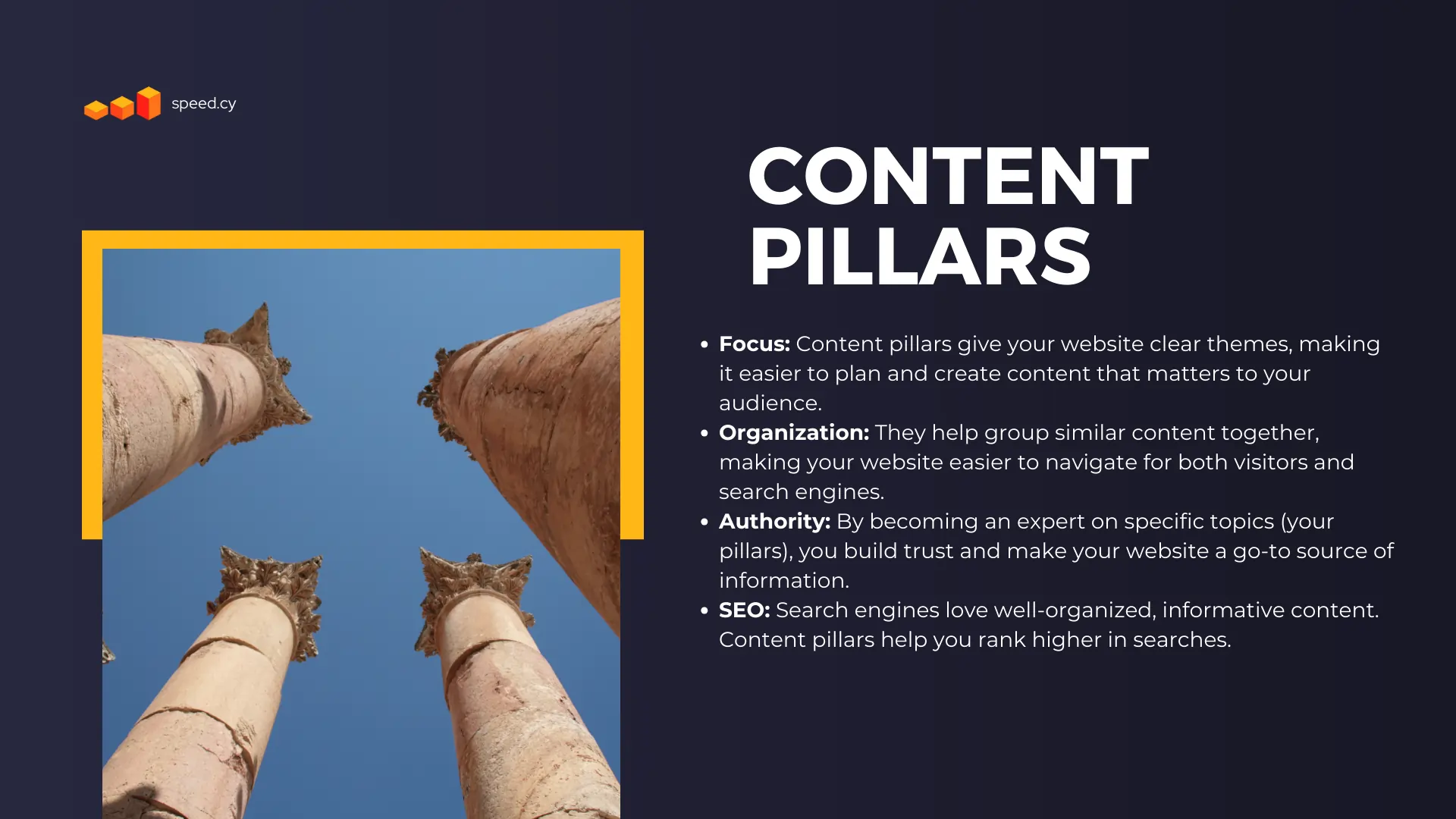Developing strong content pillars is a critical part of any modern brand’s content strategy. But what exactly are content pillars, and how can you craft ones that truly resonate with your target audience while elevating brand awareness?
In this comprehensive guide, we’ll cover proven tactics for identifying and shaping content pillars that educate and entertain your customers. You’ll learn how to select themes that align with your brand values, tailor content to maximize engagement, maintain consistency across channels, and continually optimize your pillars over time.
Let’s dive in!
What Are Content Pillars and Why Do You Need Them?
Content pillars are the core themes and topics that all of your content efforts revolve around. They reflect your brand’s areas of expertise, knowledge and voice.
Here are some key reasons why content pillars are essential for boosting brand awareness in today’s digital landscape:
- Stand out from the crowd: Developing distinct content pillars focused on your unique value proposition helps differentiate your brand from competitors.
- Attract your audience: Content pillars allow you to consistently create content tailored to your buyer personas’ interests and needs.
- Strengthen trust and loyalty: Informative, entertaining pillar content educates customers and builds affinity with your brand over time.
- Enable organic discovery: Pillars give search engines clear signals about your brand’s focus areas, facilitating SEO through relevant keyword targeting.
“Companies that blog receive 97% more links to their website than companies that don’t blog” – Hubspot
With strong content pillars as the backbone of your strategy, you can significantly multiply your brand awareness and establish connections through consistent, high-value experiences across channels.

Step 1: Identify Your Brand’s Core Themes
The first step is analyzing your brand DNA – who you are, what you stand for and what makes you unique. This will reveal the core themes to build your content pillars around.
Here are some techniques for determining central topics for your brand:
Examine Your Brand Ethos and Goals
What values, mission and personality define your brand? What goals are you trying to achieve through your content and marketing efforts?
Your content pillars should clearly convey your ethos and support your strategic business objectives. For example, an eco-friendly fashion brand’s content might focus on sustainability, ethical manufacturing and natural fabrics.
Analyze Your Target Audience and Buyer Personas
Understanding your audience is key. Determine your target demographics and create detailed buyer personas outlining their interests, pain points, goals and preferred content format.
Aligning pillars with your personas’ informational needs and consumption habits ensures your content will resonate and attract the right people. Fashion content for 18-25 year olds may look quite different from those targeting upper middle class mothers for instance.
Consider Your Areas of Expertise and Competitive Edges
What unique knowledge, skills and experience set your brand apart? Your content pillars should focus on conveying this value.
For example, an accounting firm specializing in small business taxes could have pillars on common tax deductions, filing quarterly estimated taxes, and choosing the right business entity. Their expertise makes them well-suited to educate clients and attract leads.
Identify Current Customer Pain Points and Questions
Analyze sales conversations, customer support tickets and product reviews to uncover your audience’s biggest challenges and knowledge gaps. This real-world insight should inform your content pillar selection.
For example, a review of customer service calls may reveal that many users struggle with getting started and onboarding. The brand now knows an onboarding and setup focused pillar is needed.
Stay On Top of Trends and Changes in Your Industry
Keep tabs on new technologies, practices, regulations and consumer preferences. Staying up-to-date allows you to create timely educational content as your industry evolves.
For example, a food brand may develop recipes and articles focused on new superfood trends, popular diets or sustainability in response to rising consumer interest.
Let’s look at some examples of how leading brands leverage focused content pillars:
Everlane (Fashion): Sustainability, Ethical Factories, Exceptional Quality
Salesforce (Tech): Customer Success, Business Productivity, Cloud Platform
Amex (Finance): Premium Service, Business Solutions, Rewards
As you can see, strong content pillar keywords clearly reflect each brand’s positioning. Now let’s look at shaping pillar content.
Step 2: Shape Content That Resonates
With your pillars defined, the next step is developing exceptional content tailored to your audience across these themes. Follow these tips:
Match Content Style With Audience Preferences
Are your personas more likely to consume breezy listicles or detailed case studies?
Create content that aligns with your audience’s style preferences across pillars to maximize engagement. Analyze metrics on existing content as well. For example, eBooks may convert better for bottom-of-funnel leads while quick tips attract the early awareness stage.
Diversify Content Types
Don’t limit yourself to just blogging under each pillar. Aim to produce a mix of content types including:
- Blog posts
- Ebooks and guides
- Webinars
- Podcasts
- Infographics
- Videos
- Quizzes
This provides variety within your pillars while allowing you to showcase expertise through multiple formats.
Tailor Content for Each Platform and Use Case
While your pillars remain consistent, adapt the presentation and format of content to suit each platform whether that’s Instagram, YouTube, LinkedIn or elsewhere.
Similarly, craft messaging appropriate for each use case – like homepage banners, email campaigns, social posts or gated assets.
Always Keep Your Audience’s Needs Front and Center
As you develop content under each pillar keyword, routinely ask:
- How is this useful for my audience?
- What questions or problems does it help solve?
- Why should they care?
- Is the tone friendly, relatable and engaging?
Keeping your personas at the heart of content creation ensures maximum relevance.
Continuously Test and Iterate Based on Data
Pay attention to the engagement metrics for each piece of pillar content – shares, clicks, conversions etc. Any underperforming content should be refreshed or replaced.
You can also survey users directly or leverage focus groups to gain feedback for improving your pillars over time.
By continually testing and optimizing, you’ll craft content that hits the mark.
Step 3: Maintain Consistent Messaging Across Channels
While your content may vary across formats and platforms, your core messaging and voice should remain consistent everywhere.
Maintaining cohesive pillars is key for establishing trust and recognition. Follow these guidelines:
Create Clear Processes and Guidelines
Develop brand style guides, editorial calendars, approval workflows, glossaries and templates to align distributed teams. Conduct regular trainings as well.
Ensure Brand Values and Personality Shine Through
Infuse on-brand messaging into content that reflects your values and personality. This ties back to understanding your ethos.
Empower Local Market Teams With Clear Direction
For global businesses, provide local social media and content teams with guidance and assets to adapt while preserving brand voice.
Review Pillars and Content Work Regularly
Continuous oversight of content across regions and departments helps identify any gaps or inconsistencies to address.
With strong processes and governance, your brand voice will shine through consistently, boosting recognition and trust.
Step 4: Track Performance and Continuously Optimize Pillars
Measuring content pillar performance and iterating regularly based on insights is critical for maximizing impact over time.
Define Key Metrics and Track Them
Establish success metrics and KPIs to evaluate pillars against. Key quantitative metrics include:
- Brand awareness (social mentions, searches etc.)
- Engagement (social interactions, email click rate etc.)
- Lead generation (form fills, downloads etc.)
- Web traffic (page views, time on site etc.)
And qualitative survey metrics like:
- Audience knowledge gain
- Enjoyment, trust with brand
- Motivation to purchase
Analyze Results With Both Macro and Micro Views
Assess pillars at a high level for overall impact. But also go granular to see how specific pieces perform under each. This informs optimization.
Double Down on High-Performing Pillars
If a pillar produces standout results, dedicate additional resources to this theme.
For example, expand pillar content diversity, increase promotion, develop gated assets for lead gen.
Identify and Improve Underperforming Pillars
Pillars that consistently lag likely need refreshment. Audit for issues:
- Content not matching audience needs or interests
- Poor keyword optimization
- Ineffective formats
- Promotion gaps
Address these for lift.
Know When to Retire Outdated Pillars
Stay on top of trends and be ready to retire stale pillars that no longer engage your audience. Be willing to evolve your mix over time.
Continuous optimization ensures your pillars stay relevant, keeping audiences engaged.
Step 5: Expand and Evolve Your Pillars Over Time
Your initial pillars provide a strong foundation for building awareness and engagement. But brands must continually assess and expand content themes in response to changes.
Grow Your Pillar Portfolio to Match Brand Growth
As you expand into new products, services and markets, develop additional pillars that make sense. However, start small and grow gradually. Jumping to 15 pillars overnight is unwieldy.
Keep Pace With Audience and Industry Changes
Evolve and introduce new pillars aligned with audience needs as interests shift. Likewise, cover emerging topics in your space. But retire outdated themes.
Mix Evergreen and Timely Content
Balance pillars focused on evergreen fundamentals of your brand and industry with ones centered on timely trends, events and stories.
Let Your Expertise and Creativity Shine Through
View new pillars as a chance to showcase different areas of expertise and creative storytelling methods – while remaining on-brand.
By continually evaluating your content pillars using the steps outlined, your brand will stay closely connected with your audience. You’ll effectively educate and engage them while significantly boosting organic brand awareness.
Just remember – quality over quantity. Focus on developing truly stellar content under a few core pillars first before expanding. With smart, consistent and audience-aligned content pillars infused across all of your marketing, you’ll see tangible lifts in business success.
Key Takeaways and Final Thoughts

- Content pillars reflect your brand’s core focus areas and strengths. They provide a framework for high-value awareness and engagement.
- Know your brand ethos, audience needs, expertise and industry trends to pick resonant themes.
- Diversify formats like blogs, videos, eBooks but maintain consistent voice across pillars.
- Analyze performance and continually optimize pillars. Expand or retire themes as needed over time.
Developing world-class, high-ROI content pillars takes work – but pays dividends. With the blueprint provided in this guide, you have an actionable plan for cultivating content pillars that educates audiences while staying true to your brand story.
Now it’s time to outline your themes and start producing content that gets results! Feel free to reach out on social media with any additional questions.





